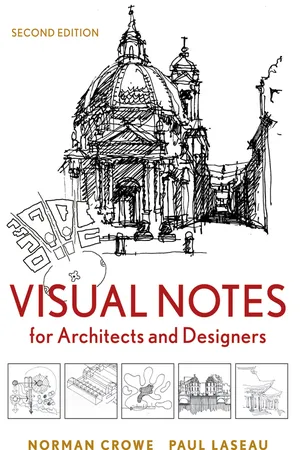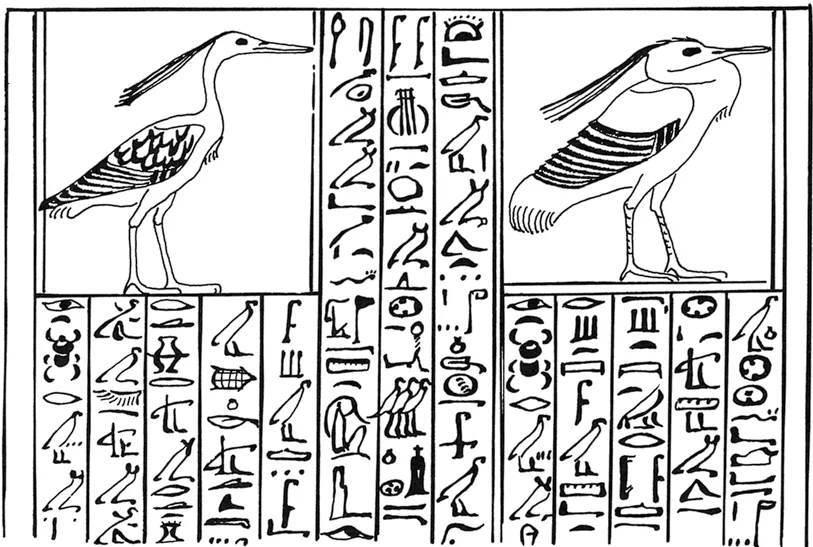![]()
Introduction
Visual notes are simply the graphic equivalent of written notes. “Taking visual notes” refers to recording information which is primarily visual and, therefore, could not be recorded as effectively with words.
Keeping notes has always been an effective hedge against an imperfect memory. Moreover, the act of taking notes, selecting and sifting through them, is an important tool for creativity. Keeping a notebook of observations and experiences is a very old custom. Once visual notes were seen by architects to be nearly as important as verbal ones. Sketching was a common part of travel and education for the young architect.
Since the availability of easy, inexpensive photography, however, visual note-taking has declined. With this decline has come a decline in visual literacy in general. We have come to rely upon a camera to do all that notational sketches once did. Of course, a camera can do much of what sketching once did and it can perform certain tasks much faster and better. But a camera cannot record concepts, underlying structure, schematic organization, or anything else that the eye cannot see all at once. Although the camera can be used creatively, it does not require any more than a superficial level of interaction between the observer and the view. It can become a comparatively neutral instrument which neither demands a high degree of selectivity nor promotes out of necessity a very high level of understanding. Le Corbusier said that cameras “get in the way of seeing.” Because visual notes do not accompany verbal ones as frequently as they once did, we believe that something valuable has been lost. It is our purpose to encourage the development and use of visual skills, especially in the form of simple, rapid, effective visual notation. We contend that the stigma against the use of graphic skills by those other than artists is based upon a false assumption that one must be an artist, heavily endowed with artistic aptitudes, in order to draw. Although a certain kind of drawing is the province of artists, that should not discourage others from using drawings to communicate information any more than one might refuse to ever write anything down because one is not an accomplished journalist or author. Making visual notes can be useful and effective and it can also be a particularly enjoyable endeavor. Once one has gotten beyond the notion that one’s drawings have to be works of art, the activity of drawing gains a momentum of its own and inevitably provides a certain satisfaction of its own.
The Uses of Visual Notes
Who would have need for making visual notes? It might be: an engineer inspecting machinery, a scientist or laboratory technician recording a particular arrangement of apparatus, a landscape architect noting an exemplary design, an architect recording important details of a building which he intends to remodel or expand, a traveler wishing to record what lies beyond myriad impressions as he explores a new place, or a student simply taking notes during a slide lecture in biology, botany, anthropology, architectural or art history or other subject where visual form is a concern.
Visual notation has an additional important use. It records that which cannot be seen directly by the eye or by a camera. A laboratory technician draws a diagram of the assembly of various apparatus; it would not be useful for him to draw a picture of the laboratory. The architect’s drawing demonstrates how the building he is studying is organized, a plan of how the circulation system works, or how and where the structural elements relate to the other parts of the building. A botanist draws an exploded view of a portion of a plant, showing how sustenance is carried through the veining to distant parts of the plant and how the flower’s reproductive parts fit together. Visual notes record information which has been selected to be stored, studied, and communicated. Such drawings are often analytical; they take apart and describe rather than simply represent as in a picture. Compared to an artist’s drawings, like a sketch of a scene, visual notes require a lot of thought and comparably less skill because they are intended to disclose selective information, while the sketch of a scene requires little forethought but considerable skill to become an accurate depiction.
There is, however, still another important dimension to visual notation. We may be left with the impression that this form of graphic communication is only of concern to technologists and other professionals who require it for the conduct of their work, and that it is simply a useful, marketable skill. The effect, however, runs deeper. Consider an analogous situation: the effect of written language upon thoughts and actions. Not only does written language, with its commonly accepted vocabulary and grammar, communicate ideas, but it actually conditions the way we think. Moreover, it communicates our own thoughts, concepts, and ideas back to us. We use it to organize our thoughts as one does when one assembles what he has learned about a particular topic, records his thoughts and, finally, "gets it all down" in writing. It is in the act of "getting it all down" that new associations and understanding emerge as a result of giving order to what would otherwise be merely random thoughts and inert, factual circumstances. It is not surprising, therefore, that societies which had not developed a written language are not comparable with literate societies in terms of the quality of their accomplishments.
Written language does have its limitations. Visual information is not as easily conveyed by the written word. Skillful writers have given us a special literary richness by describing something they wish us to see and feel, such as Balzac’s description of the interior of an apartment on the Place des Vosges, or the Roman naturalist and writer Pliny’s description of his villas in Italy in letters to his friends. But literature cannot convey all that seeing can provide. As in literature, the two drawings on the right represent a fanciful transformation from factual reality into a fantasy at the level of good fiction writing. The ritual mask was indeed inspired by a lion, but now it is a thing of the imagination. Perhaps the ancient artist first drew a lion from life to grasp the essential characteristics of “lion-ness,” then transformed those same characteristics into something intentionally different though faithful nonetheless to the factual lion. Visual media in the form of drawing is capable of playing with the imagination in the same way as in literature.
It follows that just as verbal description is a source for a rich and profound level of understanding, visual literacy can provide its own access to a level of richness and understanding which would otherwise be unreachable. In our earlier description of the engineer, technician, scientist, and others making visual notes in order to facilitate their work, the impression might be that such notation is simply a means for the transfer of information. Certainly notes might serve only as information transfer and they might only be perceived as such. Although basic factual information is inert and without an intrinsic value, the very act of gathering the material, selecting, sorting, and “getting it down” can disclose new associations and promote a deeper understanding than any superficial observation could provide.
Communication, whether it is through literature, mathematics, music, or graphics, is at the very heart of creativity which thrives upon relationships drawn between symbols and ideas. The ext...







